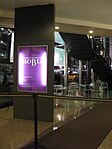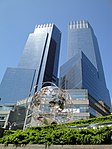The Sofia

The Sofia (formerly the Kent Automatic Garage and the Sofia Brothers Warehouse) is a condominium building at the corner of Columbus Avenue and 61st Street on the Upper West Side of Manhattan in New York City. It was constructed from 1929 to 1930 and was designed by the firm of Jardine, Hill & Murdock in the Art Deco style for Kent Automatic Garages. The Sofia is 27 stories tall; the first nine stories above the ground level are used as offices, while the top 17 stories contain residential condominiums. The building is a New York City designated landmark and on the National Register of Historic Places. The building originally functioned as a 1,000-spot garage, with a gas station at the corner of Columbus Avenue and 61st Street. The ground level contains multiple entrances, surrounded by multicolored pieces of terracotta. There was a vehicular entrance on Columbus Avenue and an exit on 61st Street. On the upper floors, the facade is made largely of orange brick, interspersed with bands of black brick, and there are several setbacks with terracotta parapets. The building contains an extremely strong steel superstructure inside. Originally, the building had large vehicular elevators, as well as electric trolleys on each floor, which automatically transported vehicles to parking spots. Since the 1980s, the building has contained 94 apartments, ranging from studio apartments to three-bedroom units. Kent Automatic Garages bought the site from automobile company Packard in 1928, and the garage opened on July 30, 1930. Kent obtained various loans to finance the building's construction, but it lost the building to foreclosure within a year. The building was then acquired by the Central Savings Bank in 1936 and by the Sofia Brothers Warehousing Company in 1944. The Sofia family converted the building into a warehouse, though the structure also housed offices and studios. Aaron Green and Growth Realty Companies bought the building for $9.3 million in August 1983 and converted it into a residential and commercial condominium over the next year. College Board occupied the commercial portion of the building from the 1980s until 2015, when Fordham University acquired the commercial space.
Excerpt from the Wikipedia article The Sofia (License: CC BY-SA 3.0, Authors, Images).The Sofia
West 61st Street, New York Manhattan
Geographical coordinates (GPS) Address Nearby Places Show on map
Geographical coordinates (GPS)
| Latitude | Longitude |
|---|---|
| N 40.770555555556 ° | E -73.983333333333 ° |
Address
The Sofia
West 61st Street 43
10023 New York, Manhattan
New York, United States
Open on Google Maps







